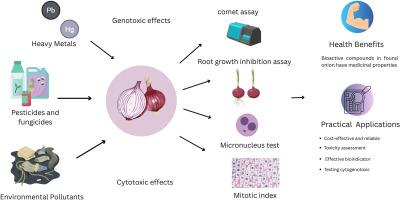葱属植物作为生物指示物:遗传毒性和细胞毒性评价方法综述
IF 2.4
4区 医学
Q2 PHARMACOLOGY & PHARMACY
引用次数: 0
摘要
Allium cepa L.,俗称球茎洋葱,在全球广泛种植和使用,用于烹饪和药用目的。它在遗传毒性和细胞毒性检测中起着重要作用。洋葱(Allium cepa L.)是一种多年生草本植物,以其高膳食纤维含量而闻名。它是一种二年生植物,有纤维的不定根,3-8片二列白霜叶,球茎由同心的、扩大的肉质叶基部组成。外层的叶基变干,变薄,颜色变化,形成保护层,而内层的叶基随着球茎成熟而变厚。葱属植物在食品工业中被广泛用作调味剂,并以其抗菌特性而闻名。本文综述了通过分析染色体畸变和DNA损伤来评价葱属植物遗传毒性的一种经济有效的方法。该试验提供了一种替代动物试验的方法,包括各种遗传毒性评估方法,如彗星试验和微核试验,以及细胞毒性评估技术,如MTT试验和根生长抑制试验。强调了葱对环境污染物和破坏生理过程的重金属的敏感性。本文还综述了洋葱中硫化合物、皂苷和果聚糖等生物活性物质对健康的益处,强调了葱属植物在环境监测中的重要性。此外,本文还探讨了代森锌和苯丹尼等杀菌剂对环境和人体健康的影响,并将葱属植物作为检测染色体和有丝分裂紊乱的生物指标。本文综述了葱属植物在环境监测中的应用价值、在毒性评价和研究中的广泛应用以及葱属植物的历史和现代医学用途。目的是汇编有关葱的植物化学、遗传毒性和细胞毒性的最新证据,强调其在环境和毒理学研究中作为标准生物指示剂的作用。展望未来,将葱属植物的检测方法与分子和组学方法相结合,可以进一步提高葱属植物在现代环境监测和药物毒理学中的应用价值。本文章由计算机程序翻译,如有差异,请以英文原文为准。

Allium cepa L. as a bioindicator: A comprehensive review of genotoxicity and cytotoxicity assessment methods
Allium cepa L., commonly known as the bulb onion, is widely cultivated and used globally for its culinary and medicinal purposes. It plays a significant role in genotoxicity and cytotoxicity testing. Onion (Allium cepa L.), a perennial herb from the Amaryllidaceae family, is recognized for its high dietary fiber content. It is a biennial plant with fibrous, adventitious roots, 3–8 distichous, glaucous leaves, and a bulb made up of concentric, enlarged, fleshy leaf bases. The outer leaf bases dry out, becoming thin and varying in color to form a protective layer, while the inner bases thicken as the bulb matures. Allium cepa L. is widely used as a flavoring agent in the food industry and is known for its antimicrobial properties. This review discusses the Allium cepa L. assay (AT) as an effective and economical method for evaluating genotoxic effects through the analysis of chromosomal aberrations and DNA damage. This assay provides an alternative to animal testing and includes various methods for genotoxicity assessment, such as the comet assay and micronucleus assay, as well as techniques for cytotoxicity evaluation like the MTT assay and root growth inhibition assay. It emphasizes the sensitivity of Allium cepa L. to environmental pollutants and heavy metals that disrupt physiological processes. The article also reviews the health benefits of bioactive compounds in onions, such as sulfur compounds, saponins, and fructans, highlighting the importance of Allium cepa L. in environmental monitoring. Additionally, the review examines the impact of fungicides like mancozeb and benodanil on environmental and human health, using Allium cepa L. as a bioindicator to detect chromosomal and mitotic disturbances. This comprehensive review underscores the value of Allium cepa L. in environmental monitoring, its wide range of applications in toxicity assessment and research, as well as its historical and modern uses in medicine. The aim is to compile current evidence on the phytochemistry, genotoxicity, and cytotoxicity of Allium cepa L., emphasizing its role as a standard bioindicator in environmental and toxicological studies. Looking ahead, integrating Allium cepa L. assays with molecular and omics-based approaches could further enhance their utility in modern environmental monitoring and pharmaceutical toxicology.
求助全文
通过发布文献求助,成功后即可免费获取论文全文。
去求助
来源期刊

Toxicon
医学-毒理学
CiteScore
4.80
自引率
10.70%
发文量
358
审稿时长
68 days
期刊介绍:
Toxicon has an open access mirror Toxicon: X, sharing the same aims and scope, editorial team, submission system and rigorous peer review. An introductory offer Toxicon: X - full waiver of the Open Access fee.
Toxicon''s "aims and scope" are to publish:
-articles containing the results of original research on problems related to toxins derived from animals, plants and microorganisms
-papers on novel findings related to the chemical, pharmacological, toxicological, and immunological properties of natural toxins
-molecular biological studies of toxins and other genes from poisonous and venomous organisms that advance understanding of the role or function of toxins
-clinical observations on poisoning and envenoming where a new therapeutic principle has been proposed or a decidedly superior clinical result has been obtained.
-material on the use of toxins as tools in studying biological processes and material on subjects related to venom and antivenom problems.
-articles on the translational application of toxins, for example as drugs and insecticides
-epidemiological studies on envenoming or poisoning, so long as they highlight a previously unrecognised medical problem or provide insight into the prevention or medical treatment of envenoming or poisoning. Retrospective surveys of hospital records, especially those lacking species identification, will not be considered for publication. Properly designed prospective community-based surveys are strongly encouraged.
-articles describing well-known activities of venoms, such as antibacterial, anticancer, and analgesic activities of arachnid venoms, without any attempt to define the mechanism of action or purify the active component, will not be considered for publication in Toxicon.
-review articles on problems related to toxinology.
To encourage the exchange of ideas, sections of the journal may be devoted to Short Communications, Letters to the Editor and activities of the affiliated societies.
 求助内容:
求助内容: 应助结果提醒方式:
应助结果提醒方式:


